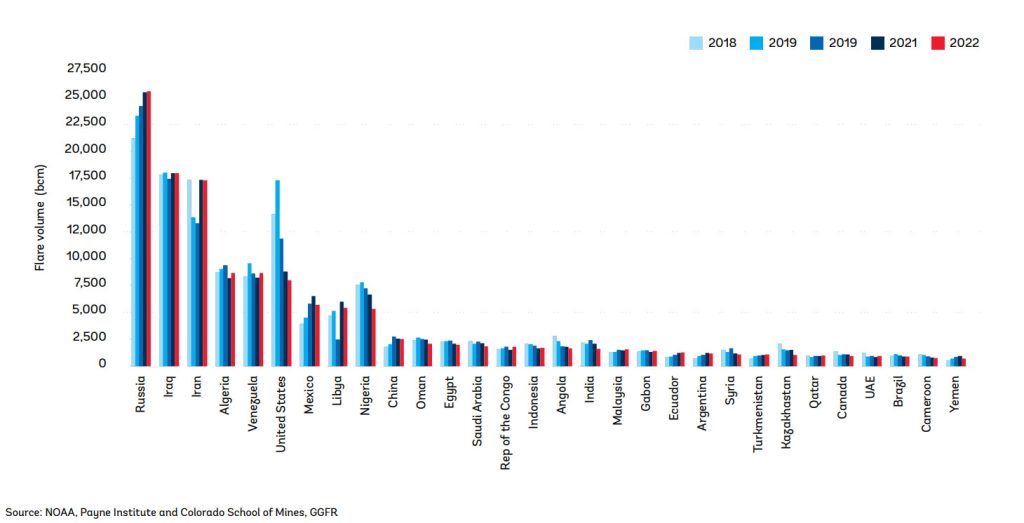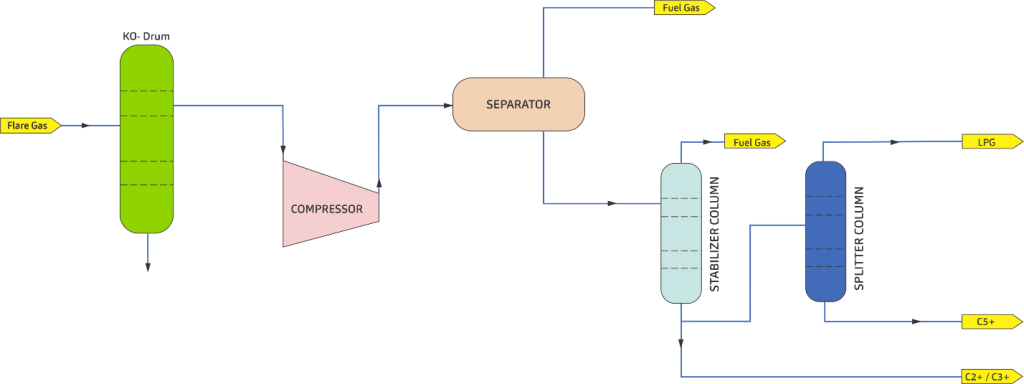Due to the increasing demand of fossil fuels usage which causes more harvesting and extraction from oil fields, the increment of associated gas production has been also observed. In most cases, the absence of feasible process leads to the unwanted burning of this valuable gas.
Also in many plants, burning undesirable gases under normal or abnormal operating conditions is regarded as a standard and safe method to maintain or control the pressure of the operating unit.
In addition to the waste of energy and destruction of huge capital, burning associated gases also has a dreadful environmental impacts. The application of flare gas recovery methods, in small and medium scale plants can be regarded as one of the cost-effective approaches to utilize flare gases and produce value-added products such as C2+, C3+, C5+, LPG. It also should be noted that the purge gas which is also called returned gas can be employed as turbine and furnace feed according to the calorific value of these gases. According to reports provided by reliable international sources such as the International Energy Agency in 2019 and the World Bank in 2022, Iran is placed in top three countries in environmental releases through gas flaring. Referring to the chart reported by the World Bank in Figure 1, despite the efforts made to eliminate or reduce the amount of flare gases, Iran still has a high potential in implementing flare gas recovery plants.


Due to the fact that the gases sent to the flare are originated from various sources, therefore, they differ in chemical composition. These compounds mainly consist of light components such as ethane and methane and some few components which are heavier than pentane. Also, according to the nature of the hydrocarbon resources or the upstream process, the compounds sent to the flare can include inert gases such as N2 or CO2. Among the streams with hydrocarbon compounds, the presence of H2S and CO2 cause pretreatment requirements before the main process so called flare gas recovery. In general, the presence of H2S and CO2 leads to the addition of the gas sweetening process before the flare gas recovery process. Additional to the above notes, considering that no fixed chemical composition exists for flare gases, the selection and design of the flare gas recovery unit is done based on continuous sampling and detailed analysis of the feed streams.
Relying on its technical and engineering capabilities, HAVAYAR industrial group has the experience of designing, construction, pre commissioning and commissioning of the flare gas recovery systems. Among the successful experiences of HAVAYAR industrial group in this field, we can refer to the flare gas recovery project in Cheshmeh Khosh oil field.
Oil field specifications:
Cheshmeh Khosh field is one of Iran’s oil fields, which is located in Dasht Abbas region of Ilam province, 52 km south of Dehloran city and 70 km west of Andimshek city. Cheshmeh Khosh field was discovered in 1964 and its exploitation has been started in 1975.
The crude oil production capacity of the Cheshmeh Khosh field is an average of 80,000 barrels per day, and 115 million cubic feet of natural gas per day. The oil produced in the field undergoes post treatment in Cheshmeh Khosh operational unit and then is transported to Ahvaz-3 operational complex through a 153 km pipeline and finally sent to Khark Island through the oil terminal to supply refineries or export.
Gas specifications:
Component
| Mol % |
C1 | 73 |
C2 | 15 |
C3 | 6 |
C4 | 2 |
C5+ | 1.9 |
H2O | 0.5 |
CO2 | 0.8 |
N2 | 0.8 |
Recovery of flare gases from Cheshmeh Khosh oil field:
In March of 2019, HAVAYAR industrial group, relying on its previous knowledge and experience, decided to define the flare gas recovery project in Cheshmeh Khosh oil field. With the aim of touching goals of the project, all feasibility studies, basic and detailed design, were carried out in an engineering department of HAVAYAR industrial group. Further, by considering the ability of manufacturing some main equipment in HAVAYAR shop, the required fixed and rotating components of this project was designed and manufactured by HAVAYAR industrial group.
Also according to the executive experience available in HAVAYAR, all stages of site preparation, installation, pre-commissioning, commissioning and operation were also carried out by HAVAYAR to complete this EPC project cycle from beginning to the end.
Finally, after 17 months of hard works, in August 1401, the Cheshmeh Khosh flare gas recovery plant of HAVAYAR was completely fall in the path of production and the product with the desired quality and spec was placed in the portfolio of HAVAYAR’s products.
Figure 2 illustrates the overall diagram of the flare gas recovery process. Based on successful experience in this field, HAVAYAR has the ability to perform all engineering phases, including feasibility studies, basic and detailed design, as well as all phases of construction, implementation and operation.
The products obtained from Cheshmeh Khosh site include the following which can be utilized by refining, petrochemical and power plant units:
- Fuel gas
- C2+
- C3+
- LPG
- C5+


